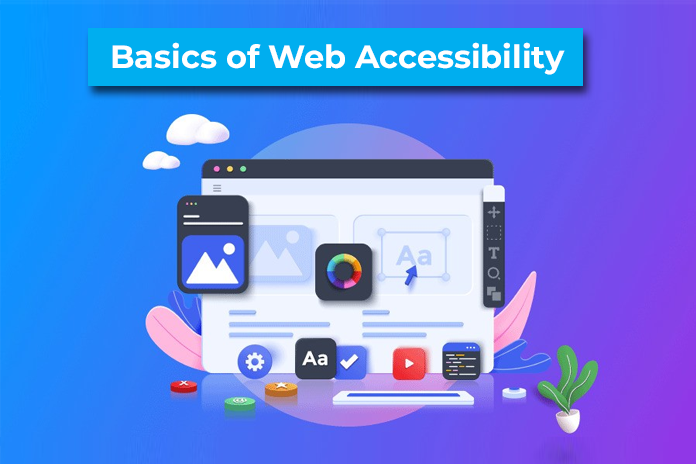Introduction
In today’s digital age, web accessibility is crucial for creating inclusive online environments. Ensuring that websites are accessible to all users, including those with disabilities, is not only a legal and ethical responsibility but also beneficial for business. This comprehensive guide will help you understand the basics of web accessibility and provide actionable tips to create more inclusive web experiences.
What is Web Accessibility?
Web accessibility refers to the practice of designing websites and web applications that can be used by everyone, including people with disabilities. This encompasses a wide range of disabilities, including visual, auditory, motor, and cognitive impairments.
The Legal Framework for Web Accessibility
Various laws and guidelines govern web accessibility, ensuring that digital content is accessible to all users:
- ADA (Americans with Disabilities Act): Requires businesses to provide accessible websites.
- WCAG (Web Content Accessibility Guidelines): International guidelines for web accessibility.
- Section 508: U.S. law requiring federal agencies to make their electronic and information technology accessible.
Why Web Accessibility Matters
Web accessibility is essential for several reasons:
- Social: Ensures equal access to information and services for all users.
- Ethical: Reflects a commitment to inclusion and diversity.
- Business: Broadens your audience and improves user experience, potentially increasing conversions and customer loyalty.
Common Barriers to Accessibility
Understanding common accessibility barriers helps in designing inclusive websites:
- Visual: Issues with sight, including blindness and color blindness.
- Auditory: Hearing impairments affecting the ability to access audio content.
- Motor: Difficulties with fine motor skills, affecting the ability to use a mouse or keyboard.
- Cognitive: Challenges with understanding or processing information.
Principles of Accessible Design
The POUR principles form the foundation of accessible design:
- Perceivable: Information must be presented in ways that users can perceive.
- Operable: Interface elements must be operable by all users.
- Understandable: Information and operation must be understandable.
- Robust: Content must be robust enough to be interpreted by various user agents, including assistive technologies.
Designing for Visual Impairments
To accommodate users with visual impairments:
- Screen Readers: Ensure your site is compatible with screen readers.
- Color Contrast: Use high contrast between text and background for readability.
Designing for Auditory Impairments
For users with hearing impairments:
- Subtitles and Transcripts: Provide text alternatives for audio content.
- Sign Language: Consider offering sign language interpretation for critical content.
Designing for Motor Impairments
To assist users with motor impairments:
- Keyboard Navigation: Ensure all functions can be accessed via keyboard.
- Switch Devices: Support alternative input devices, like switch controls.
Designing for Cognitive Impairments
For users with cognitive impairments:
- Simple Language: Use clear and straightforward language.
- Clear Layout: Structure content in a logical and consistent manner.
Tools for Testing Web Accessibility
Various tools can help you test and improve web accessibility:
- WAVE: Web Accessibility Evaluation Tool.
- AXE: Accessibility testing engine.
- Lighthouse: Chrome extension for accessibility audits.
Creating Accessible Multimedia Content
Ensure your multimedia content is accessible by:
- Providing Captions: For videos and audio content.
- Descriptive Transcripts: Detailed text descriptions of audio and video content.
Implementing ARIA Landmarks
ARIA (Accessible Rich Internet Applications) landmarks enhance navigation for screen readers:
- Role Attributes: Use ARIA roles to define regions of a webpage.
- Navigation Landmarks: Identify key areas like navigation menus, main content, and footers.
Accessible Forms and Inputs
Forms are a critical part of web accessibility:
- Labels: Ensure all form fields have descriptive labels.
- Instructions: Provide clear instructions for filling out forms.
- Error Messages: Offer accessible error messages that help users correct mistakes.
SEO and Web Accessibility
Accessibility and SEO often go hand in hand:
- Improved SEO: Accessible sites tend to rank better in search engines.
- Better User Experience: Accessibility improvements can enhance overall user experience, reducing bounce rates.
User Testing for Accessibility
Involving users with disabilities in testing:
- Feedback: Gather feedback from users with disabilities.
- Real-World Testing: Conduct usability testing to identify accessibility issues.
Maintaining Accessibility
Accessibility is an ongoing process:
- Regular Audits: Conduct periodic accessibility audits.
- Updates: Ensure that updates and new content adhere to accessibility standards.
Accessibility in Mobile Web Design
Mobile accessibility considerations:
- Responsive Design: Ensure your site adapts to different screen sizes.
- Touch Targets: Design large touch targets for users with motor impairments.
The Role of Web Developers in Accessibility
Developers play a crucial role in ensuring accessibility:
- Best Practices: Follow coding best practices for accessibility.
- Education: Stay informed about the latest accessibility guidelines and tools.
Conclusion
Understanding and implementing web accessibility is essential for creating inclusive and effective websites. By following the principles and best practices outlined in this guide, you can ensure your website is accessible to all users, enhancing their experience and expanding your audience.
FAQs
What is web accessibility?
Web accessibility ensures that websites and web applications are usable by everyone, including people with disabilities.
Why is web accessibility important?
It provides equal access to information and services, reflects a commitment to inclusion, and can improve SEO and user experience.
What are the WCAG guidelines?
The Web Content Accessibility Guidelines (WCAG) are international standards for web accessibility, providing recommendations for making web content accessible.
How can I test my website for accessibility?
Use tools like WAVE, AXE, and Lighthouse to evaluate your site’s accessibility and identify areas for improvement.
What are ARIA landmarks?
ARIA landmarks are roles and attributes used to improve navigation for screen readers, enhancing accessibility.
Read More: The Benefits of Using Static Site Generators


